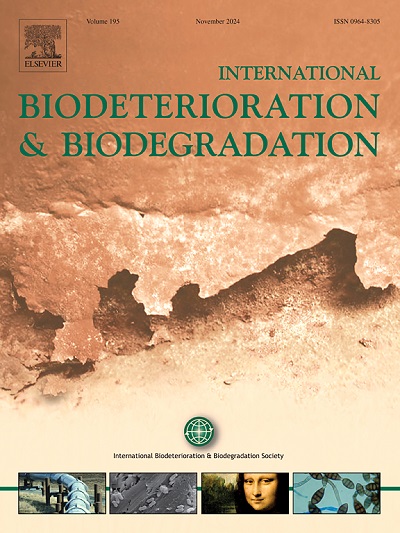石质文物的持续保护:利用抗病毒药物奥司他韦,有效消除文物上的地衣和疾病
IF 4.1
2区 环境科学与生态学
Q2 BIOTECHNOLOGY & APPLIED MICROBIOLOGY
International Biodeterioration & Biodegradation
Pub Date : 2025-04-27
DOI:10.1016/j.ibiod.2025.106106
引用次数: 0
摘要
石质地衣在石质文物的变质过程中起着重要的作用。传统的杀菌剂,包括抗生素和抗真菌剂,具有耐药性发展和生物污染的风险,强调需要有效和长期治疗以防止生物恶化。本研究在四川牛角寨石窟落石地衣中发现了一种新的双链RNA (dsRNA)病毒——Pyxine petricola partitivirus 1 (PpPV1)。在全球118个地衣样本中,包括来自柬埔寨吴哥砂岩纪念碑和中国长城等著名遗址的地衣样本,在70.2%的萨氏地衣中发现了该病毒。我们开发了一种使用抗病毒药物奥司他韦的杀菌剂策略,该策略显著降低了形成地衣的藻类的病毒载量和光合活性,损害了地衣的功能。这种创新的方法不仅为石质文物保护提供了一种新的方法,而且通过预防病毒病原体和减轻地衣造成的生物损害,有助于生物防治和文物保护。本文章由计算机程序翻译,如有差异,请以英文原文为准。
Sustained protection of stone cultural relics: Utilizing antiviral oseltamivir to effectively eliminate lichen and diseases on artifacts
Saxicolous lichens, which colonize rock substrates, play a major role in the deterioration of stone cultural relics. Traditional biocides, including antibiotics and antifungal agents, pose risks of resistance development and biofouling, underscoring the need for effective and a long-term treatment against biodeterioration. In this study, we discovered a novel double-stranded RNA (dsRNA) virus, Pyxine petricola partitivirus 1 (PpPV1), in saxicolous lichens collected from the fallen stones of the Niujiaozhai grottoes in Sichuan Province, China. This virus was found in 70.2% of saxicolous lichens from a global sample of 118 lichens, including those from notable sites, including Angkor sandstone monuments in Cambodia and the Great Wall of China. We developed a biocide strategy using the antiviral oseltamivir, which significantly reduced the viral loading and the photosynthetic activity of the lichen-forming algae, impairing lichen functionality. This innovative approach not only offers a novel method for protecting stone cultural relics but also contributes to both biocontrol and heritage conservation by safeguarding against viral pathogens and mitigating the biological damage caused by lichens.
求助全文
通过发布文献求助,成功后即可免费获取论文全文。
去求助
来源期刊
CiteScore
9.60
自引率
10.40%
发文量
107
审稿时长
21 days
期刊介绍:
International Biodeterioration and Biodegradation publishes original research papers and reviews on the biological causes of deterioration or degradation.

 求助内容:
求助内容: 应助结果提醒方式:
应助结果提醒方式:


